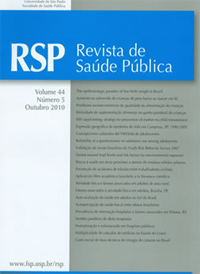
Abstract
OBJECTIVE -To present national estimates regarding walking or cycling for commuting in Brazil and in 10 metropolitan regions. METHODS - By using data from the Health section of 2008’s Pesquisa Nacional por Amostra de Domicílio (Brazil’s National Household Sample Survey), we estimated how often employed people walk or cycle to work, disaggregating our results by sex, age range, education level, household monthly income per capita, urban or rural address, metropolitan regions, and macro-regions in Brazil. Furthermore, we estimated the distribution of this same frequency according to quintiles of household monthly income per capita in each metropolitan region of the country. RESULTS - A third of the employed men and women walk or cycle from home to work in Brazil. For both sexes, this share decreases as income and education levels rise, and it is higher among younger individuals, especially among those living in rural areas and in the Northeast region of the country. Depending on the metropolitan region, the practice of active transportation is two to five times more frequent among low-income individuals than among high-income individuals. CONCLUSIONS - Walking or cycling to work in Brazil is most frequent among low-income individuals and the ones living in less economically developed areas. Active transportation evaluation in Brazil provides important information for public health and urban mobility policy-making